
Captivating audiovisual look at the role African Americans played during World War II.
- Subject:
- Social Studies
- Material Type:
- Primary Source
- Provider:
- U.S. National Archives and Records Administration
- Date Added:
- 10/03/2023

Captivating audiovisual look at the role African Americans played during World War II.
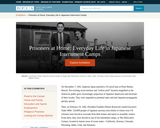
On December 7, 1941, Imperial Japan attacked a US naval base at Pearl Harbor, Hawaii. Pre-existing racial tensions and åÒyellow perilåÓ hysteria magnified as the American public grew increasingly suspicious of Japanese Americans and uncertain of their loyalty. They were regarded as potential spies and anti-Japanese propaganda quickly spread. Then, on February 19, 1942, President Franklin Delano Roosevelt issued Executive Order 9066. 120,000 people of Japanese ancestry (two-thirds of whom were US citizens) were forced to evacuate from their homes and report to assembly centers. From there, they were moved to one of ten internment camps, or War Relocation Centers, located in remote areas of seven statesåÑCalifornia, Arizona, Colorado, Wyoming, Idaho, Utah, and Arkansas.For the next three years, Japanese Americans acclimated to life behind barbed wire and under armed guard. Uprooted from their lives, they found themselves in strange and uncomfortable environments. They had to adapt to their new situation by adjusting to new living conditions, attending new schools, and finding inventive ways to pass the time. They attempted to maintain a sense of normalcy by attending religious meetings and by finding employment.This exhibition tells stories of everyday lives in Japanese Internment camps during World War II. It was created as part of the DPLAåÕs Digital Curation Program by the following students as part of Dr. Joan E. Beaudoin's course "Metadata in Theory and Practice" in the School of Library and Information Science at Wayne State University: Stephanie Chapman, Jessica Keener, Nicole Sobota, and Courtney Whitmore.
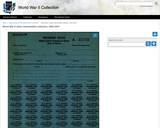
World War II ration memorabilia collection, 1942-1947.
The Office of Price Administration and Civilian Supply was established by Presidential Executive Order 8734 on April 11, 1941, in an effort to control inflation. The civilian supply function of the agency was transferred to the Office of Production Management in August of 1941 and the name was shortened to the Office of Price Administration (OPA). The Emergency Price Control Act (January 30, 1942) established the purposes of the agency as follows: to stabilize prices and rents and prevent unwarranted increases in them; to prevent profiteering, hoarding and speculation; to assure that defense appropriations were not dissipated by excessive prices; to protect those with fixed incomes from undue impairment of their living standards; to assist in securing adequate production; and to prevent a post-emergency collapse of values." The OPA fixed price ceilings on all commodities except farm products and controlled rents in defense areas. The first rationing program, for automobile tires, was initiated December 27, 1941. There were two types of rationing programs. The first was a certificate program, where an applicant had to meet eligibility standards and show need to a local ration board before receiving a certificate permitting purchase of the rationed item. This type of program was applied to ties, automobiles, typewriters, bicycles, rubber footwear and stoves. The second program was a coupon or stamp type for which all civilians were eligible. These programs were administered through local banks and covered foods, fuel oil, gasoline and shoes. Rationing continued throughout World War II and by the end of November 1945 only the sugar and rubber tire rationing programs remained. Tire rationing ceased on December 31, 1945. Sugar rationing continued until June 11, 1947. The Office of Price Administration was dissolved April 1, 1947.

View how American citizens helped to keep World War II in the home front through these posters on exhibit at the Smithsonian Museum of American History.
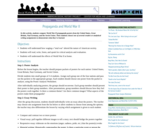
In this activity, students compare World War II propaganda posters from the United States, Great Britain, Nazi Germany, and the Soviet Union. Then students choose one of several creative or analytical writing assignments to demonstrate what they've learned.
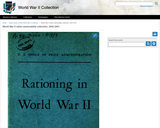
World War II ration memorabilia collection, 1942-1947.
The Office of Price Administration and Civilian Supply was established by Presidential Executive Order 8734 on April 11, 1941, in an effort to control inflation. The civilian supply function of the agency was transferred to the Office of Production Management in August of 1941 and the name was shortened to the Office of Price Administration (OPA). The Emergency Price Control Act (January 30, 1942) established the purposes of the agency as follows: to stabilize prices and rents and prevent unwarranted increases in them; to prevent profiteering, hoarding and speculation; to assure that defense appropriations were not dissipated by excessive prices; to protect those with fixed incomes from undue impairment of their living standards; to assist in securing adequate production; and to prevent a post-emergency collapse of values." The OPA fixed price ceilings on all commodities except farm products and controlled rents in defense areas. The first rationing program, for automobile tires, was initiated December 27, 1941. There were two types of rationing programs. The first was a certificate program, where an applicant had to meet eligibility standards and show need to a local ration board before receiving a certificate permitting purchase of the rationed item. This type of program was applied to ties, automobiles, typewriters, bicycles, rubber footwear and stoves. The second program was a coupon or stamp type for which all civilians were eligible. These programs were administered through local banks and covered foods, fuel oil, gasoline and shoes. Rationing continued throughout World War II and by the end of November 1945 only the sugar and rubber tire rationing programs remained. Tire rationing ceased on December 31, 1945. Sugar rationing continued until June 11, 1947. The Office of Price Administration was dissolved April 1, 1947.

This set of lessons extends over a few days. Students read and annotate Ernie Pyle's "A Long Thin Line of Anguish." Students complete a SAYS/DOES graphic organizer, working on summarizing the text, noticing the choices the author makes about use of details, and describing the choices the author makes regarding the structure of the article.
Students complete a SOAPStone handout, identifying subject, occasion, author, purpose, speaker and tone (SOAPStone is a pre-AP/AP strategy). Students develop claims about why Ernie Pyle makes the writing choices he makes. Students write an informal, free-response style assessment about the impact of Pyle's choices.
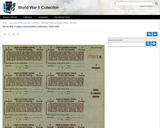
World War II ration memorabilia collection, 1942-1947.
The Office of Price Administration and Civilian Supply was established by Presidential Executive Order 8734 on April 11, 1941, in an effort to control inflation. The civilian supply function of the agency was transferred to the Office of Production Management in August of 1941 and the name was shortened to the Office of Price Administration (OPA). The Emergency Price Control Act (January 30, 1942) established the purposes of the agency as follows: to stabilize prices and rents and prevent unwarranted increases in them; to prevent profiteering, hoarding and speculation; to assure that defense appropriations were not dissipated by excessive prices; to protect those with fixed incomes from undue impairment of their living standards; to assist in securing adequate production; and to prevent a post-emergency collapse of values." The OPA fixed price ceilings on all commodities except farm products and controlled rents in defense areas. The first rationing program, for automobile tires, was initiated December 27, 1941. There were two types of rationing programs. The first was a certificate program, where an applicant had to meet eligibility standards and show need to a local ration board before receiving a certificate permitting purchase of the rationed item. This type of program was applied to ties, automobiles, typewriters, bicycles, rubber footwear and stoves. The second program was a coupon or stamp type for which all civilians were eligible. These programs were administered through local banks and covered foods, fuel oil, gasoline and shoes. Rationing continued throughout World War II and by the end of November 1945 only the sugar and rubber tire rationing programs remained. Tire rationing ceased on December 31, 1945. Sugar rationing continued until June 11, 1947. The Office of Price Administration was dissolved April 1, 1947.
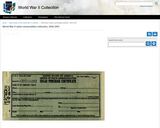
World War II ration memorabilia collection, 1942-1947.
The Office of Price Administration and Civilian Supply was established by Presidential Executive Order 8734 on April 11, 1941, in an effort to control inflation. The civilian supply function of the agency was transferred to the Office of Production Management in August of 1941 and the name was shortened to the Office of Price Administration (OPA). The Emergency Price Control Act (January 30, 1942) established the purposes of the agency as follows: to stabilize prices and rents and prevent unwarranted increases in them; to prevent profiteering, hoarding and speculation; to assure that defense appropriations were not dissipated by excessive prices; to protect those with fixed incomes from undue impairment of their living standards; to assist in securing adequate production; and to prevent a post-emergency collapse of values." The OPA fixed price ceilings on all commodities except farm products and controlled rents in defense areas. The first rationing program, for automobile tires, was initiated December 27, 1941. There were two types of rationing programs. The first was a certificate program, where an applicant had to meet eligibility standards and show need to a local ration board before receiving a certificate permitting purchase of the rationed item. This type of program was applied to ties, automobiles, typewriters, bicycles, rubber footwear and stoves. The second program was a coupon or stamp type for which all civilians were eligible. These programs were administered through local banks and covered foods, fuel oil, gasoline and shoes. Rationing continued throughout World War II and by the end of November 1945 only the sugar and rubber tire rationing programs remained. Tire rationing ceased on December 31, 1945. Sugar rationing continued until June 11, 1947. The Office of Price Administration was dissolved April 1, 1947.

Contains a map which shows the synagogues which were destroyed on Kristallnacht, Night of Broken Glass.

This site offers a detailed account of the liberation of the concentration camps by Allied forces and is accompanied by numerous photos, related website links, and video clips.

This unit consists of 23 lessons and an assessment designed to lead middle or high school students through an examination of the catastrophic period in the twentieth century when Nazi Germany murdered six million Jews and millions of other civilians, in the midst of the most destructive war in human history.
Unit Essential Question: What does learning about the choices people made during the Weimar Republic, the rise of the Nazi Party, and the Holocaust teach us about the power and impact of our choices today?

You can learn a lot about a time period from newspapers published at that time – anxieties, sources of entertainment, local and national events and more. A variety of publishers produced newspapers, each with their own point of view. This activity focuses on articles from newspapers published by labor unions during World War II in the 1940s.

Original 6 -art article. Italy, Germany and Japan enter agreement that none will agree to an armistice or peace without the reciprocal agreement of the three.

This site from the US Army describes steps taken in the United States to prepare for war. Scroll through to see how the United States mobilized for World War II.

In-depth analysis of the decision to create and drop the atomic bomb on Japan during World War II. Includes details on the Interim Committee.

This online version of a book on the US war against Japan is very extensive and filled with useful information.

U.S. History is designed to meet the scope and sequence requirements of most introductory courses. The text provides a balanced approach to U.S. history, considering the people, events, and ideas that have shaped the United States from both the top down (politics, economics, diplomacy) and bottom up (eyewitness accounts, lived experience). U.S. History covers key forces that form the American experience, with particular attention to issues of race, class, and gender.Senior Contributing AuthorsP. Scott Corbett, Ventura CollegeVolker Janssen, California State University, FullertonJohn M. Lund, Keene State CollegeTodd Pfannestiel, Clarion UniversityPaul Vickery, Oral Roberts UniversitySylvie Waskiewicz

In this second video giving an overview of World War II, we see Germany and the Axis powers only continue to gain momentum in 1940. [6:13]
Khan Academy learning modules include a Community space where users can ask questions and seek help from community members. Educators should consult with their Technology administrators to determine the use of Khan Academy learning modules in their classroom. Please review materials from external sites before sharing with students.

In 1941, the Axis gains further momentum with control of most of Continential Europe. Hitler decides to break pact and invade Stalin's Soviet Union. United States enters World War II after Japanese attack on Pearl Harbor. [12:11]
Khan Academy learning modules include a Community space where users can ask questions and seek help from community members. Educators should consult with their Technology administrators to determine the use of Khan Academy learning modules in their classroom. Please review materials from external sites before sharing with students.